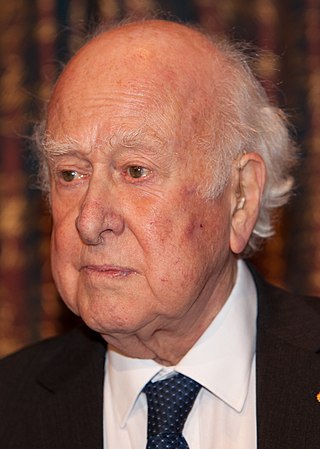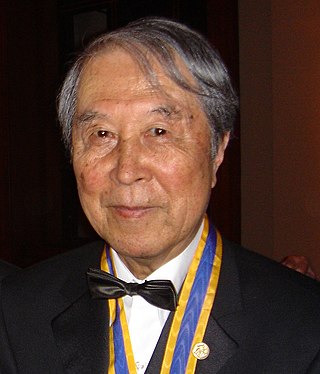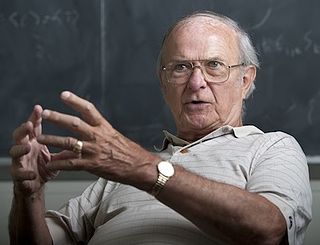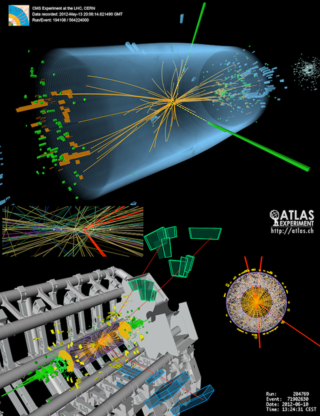Jeffrey Goldstone | |
|---|---|
| Born | 3 September 1933 Manchester, UK |
| Nationality | British |
| Alma mater | Trinity College, Cambridge |
| Known for | Goldstone boson Linked-cluster theorem |
| Scientific career | |
| Fields | Quantum mechanics |
| Institutions | MIT Cambridge |
| Doctoral advisor | Hans Bethe |
Jeffrey Goldstone (born 3 September 1933) is a British theoretical physicist and an emeritus physics faculty member at the MIT Center for Theoretical Physics.
He worked at the University of Cambridge until 1977. He is noted for the discovery of the Nambu–Goldstone boson. He is currently working on quantum computation.
Born in Manchester, he was educated at Manchester Grammar School and Trinity College, Cambridge, (B.A. 1954, Ph.D. 1958). He worked on the theory of nuclear matter under the guidance of Hans Bethe and developed modifications of Feynman diagrams for non-relativistic many-fermion systems, which are currently referred to as Goldstone diagrams. [1] In 1957, he proved the linked-cluster theorem, showing that only connected diagrams contribute to the calculation. [2]
Goldstone was a research fellow of Trinity College, Cambridge, from 1956 to 1960 and held visiting research posts at Copenhagen, CERN and Harvard. During this time, his research focus shifted to particle physics and he investigated the nature of relativistic field theories with spontaneously broken symmetries. With Abdus Salam and Steven Weinberg, he proved that in such theories zero-mass particles (Nambu–Goldstone bosons) must exist.
From 1962 to 1976, Goldstone was a faculty member at Cambridge. In the early 1970s, with Peter Goddard, Claudio Rebbi and Charles Thorn, he worked out the light-cone quantization theory of relativistic strings. He moved to the USA in 1977 as Professor of Physics at MIT, where he has been the Cecil and Ida Green Professor of Physics since 1983 and was Director of the MIT Center for Theoretical Physics from 1983-89.
Goldstone published research on solitons in quantum field theory with Roman Jackiw and Frank Wilczek, and on the quantum strong law of large numbers with Edward Farhi and Samuel Gutmann. Since 1997, he has been working, with Farhi, Gutmann, Michael Sipser and Andrew Childs, on quantum computation algorithms. [3]

In theoretical physics, quantum field theory (QFT) is a theoretical framework that combines classical field theory, special relativity, and quantum mechanics. QFT is used in particle physics to construct physical models of subatomic particles and in condensed matter physics to construct models of quasiparticles. Current standard model of particle physics is based on Quantum Field Theory

Spontaneous symmetry breaking is a spontaneous process of symmetry breaking, by which a physical system in a symmetric state spontaneously ends up in an asymmetric state. In particular, it can describe systems where the equations of motion or the Lagrangian obey symmetries, but the lowest-energy vacuum solutions do not exhibit that same symmetry. When the system goes to one of those vacuum solutions, the symmetry is broken for perturbations around that vacuum even though the entire Lagrangian retains that symmetry.

Peter Ware Higgs was a British theoretical physicist, professor at the University of Edinburgh, and Nobel laureate in Physics for his work on the mass of subatomic particles.
In particle and condensed matter physics, Goldstone bosons or Nambu–Goldstone bosons (NGBs) are bosons that appear necessarily in models exhibiting spontaneous breakdown of continuous symmetries. They were discovered by Yoichiro Nambu in particle physics within the context of the BCS superconductivity mechanism, and subsequently elucidated by Jeffrey Goldstone, and systematically generalized in the context of quantum field theory. In condensed matter physics such bosons are quasiparticles and are known as Anderson–Bogoliubov modes.

In the Standard Model of particle physics, the Higgs mechanism is essential to explain the generation mechanism of the property "mass" for gauge bosons. Without the Higgs mechanism, all bosons (one of the two classes of particles, the other being fermions) would be considered massless, but measurements show that the W+, W−, and Z0 bosons actually have relatively large masses of around 80 GeV/c2. The Higgs field resolves this conundrum. The simplest description of the mechanism adds a quantum field (the Higgs field) which permeates all of space to the Standard Model. Below some extremely high temperature, the field causes spontaneous symmetry breaking during interactions. The breaking of symmetry triggers the Higgs mechanism, causing the bosons it interacts with to have mass. In the Standard Model, the phrase "Higgs mechanism" refers specifically to the generation of masses for the W±, and Z weak gauge bosons through electroweak symmetry breaking. The Large Hadron Collider at CERN announced results consistent with the Higgs particle on 14 March 2013, making it extremely likely that the field, or one like it, exists, and explaining how the Higgs mechanism takes place in nature. The view of the Higgs mechanism as involving spontaneous symmetry breaking of a gauge symmetry is technically incorrect since by Elitzur's theorem gauge symmetries can never be spontaneously broken. Rather, the Fröhlich–Morchio–Strocchi mechanism reformulates the Higgs mechanism in an entirely gauge invariant way, generally leading to the same results.

Yoichiro Nambu was a Japanese-American physicist and professor at the University of Chicago.
The QCD vacuum is the quantum vacuum state of quantum chromodynamics (QCD). It is an example of a non-perturbative vacuum state, characterized by non-vanishing condensates such as the gluon condensate and the quark condensate in the complete theory which includes quarks. The presence of these condensates characterizes the confined phase of quark matter.

In particle physics, the history of quantum field theory starts with its creation by Paul Dirac, when he attempted to quantize the electromagnetic field in the late 1920s. Major advances in the theory were made in the 1940s and 1950s, leading to the introduction of renormalized quantum electrodynamics (QED). The field theory behind QED was so accurate and successful in predictions that efforts were made to apply the same basic concepts for the other forces of nature. Beginning in 1954, the parallel was found by way of gauge theory, leading by the late 1970s, to quantum field models of strong nuclear force and weak nuclear force, united in the modern Standard Model of particle physics.
In particle physics, chiral symmetry breaking generally refers to the dynamical spontaneous breaking of a chiral symmetry associated with massless fermions. This is usually associated with a gauge theory such as quantum chromodynamics, the quantum field theory of the strong interaction, and it also occurs through the Brout-Englert-Higgs mechanism in the electroweak interactions of the standard model. This phenomenon is analogous to magnetization and superconductivity in condensed matter physics. The basic idea was introduced to particle physics by Yoichiro Nambu, in particular, in the Nambu–Jona-Lasinio model, which is a solvable theory of composite bosons that exhibits dynamical spontaneous chiral symmetry when a 4-fermion coupling constant becomes sufficiently large. Nambu was awarded the 2008 Nobel prize in physics "for the discovery of the mechanism of spontaneous broken symmetry in subatomic physics".

Michael Fredric Sipser is an American theoretical computer scientist who has made early contributions to computational complexity theory. He is a professor of applied mathematics and was the dean of science at the Massachusetts Institute of Technology.
The MIT Center for Theoretical Physics (CTP) is the hub of theoretical nuclear physics, particle physics, and quantum information research at MIT. It is a subdivision of MIT Laboratory for Nuclear Science and Department of Physics.

Gerald Stanford "Gerry" Guralnik was the Chancellor’s Professor of Physics at Brown University. In 1964 he co-discovered the Higgs mechanism and Higgs boson with C. R. Hagen and Tom Kibble (GHK). As part of Physical Review Letters' 50th anniversary celebration, the journal recognized this discovery as one of the milestone papers in PRL history. While widely considered to have authored the most complete of the early papers on the Higgs theory, GHK were controversially not included in the 2013 Nobel Prize in Physics.

François, Baron Englert is a Belgian theoretical physicist and 2013 Nobel Prize laureate.

Carl Richard Hagen is a professor of particle physics at the University of Rochester. He is most noted for his contributions to the Standard Model and Symmetry breaking as well as the 1964 co-discovery of the Higgs mechanism and Higgs boson with Gerald Guralnik and Tom Kibble (GHK). As part of Physical Review Letters 50th anniversary celebration, the journal recognized this discovery as one of the milestone papers in PRL history. While widely considered to have authored the most complete of the early papers on the Higgs theory, GHK were controversially not included in the 2013 Nobel Prize in Physics.

Robert Brout was a Belgian-American theoretical physicist who made significant contributions in elementary particle physics. He was a professor of physics at Université Libre de Bruxelles where he had created, together with François Englert, the Service de Physique Théorique.

Christopher T. Hill is an American theoretical physicist at the Fermi National Accelerator Laboratory who did undergraduate work in physics at M.I.T., and graduate work at Caltech. Hill's Ph.D. thesis, "Higgs Scalars and the Nonleptonic Weak Interactions" (1977) contains one of the first detailed discussions of the two-Higgs-doublet model and its impact upon weak interactions. His work mainly focuses on new physics that can be probed in laboratory experiments or cosmology.

The Higgs boson, sometimes called the Higgs particle, is an elementary particle in the Standard Model of particle physics produced by the quantum excitation of the Higgs field, one of the fields in particle physics theory. In the Standard Model, the Higgs particle is a massive scalar boson with zero spin, even (positive) parity, no electric charge, and no colour charge that couples to mass. It is also very unstable, decaying into other particles almost immediately upon generation.
The 1964 PRL symmetry breaking papers were written by three teams who proposed related but different approaches to explain how mass could arise in local gauge theories. These three papers were written by: Robert Brout and François Englert; Peter Higgs; and Gerald Guralnik, C. Richard Hagen, and Tom Kibble (GHK). They are credited with the theory of the Higgs mechanism and the prediction of the Higgs field and Higgs boson. Together, these provide a theoretical means by which Goldstone's theorem can be avoided. They showed how gauge bosons can acquire non-zero masses as a result of spontaneous symmetry breaking within gauge invariant models of the universe.

Yasunori Nomura is a theoretical physicist working on particle physics, quantum gravity, and cosmology. He is a professor of physics at University of California, Berkeley, a senior faculty scientist at Lawrence Berkeley National Laboratory, a senior research scientist at Riken, and an affiliate member at Kavli Institute for the Physics and Mathematics of the Universe. Since 2015, he has been the director of the Berkeley Center for Theoretical Physics.
Edward Henry Farhi is a physicist working on quantum computation as a principal scientist at Google. In 2018 he retired from his position as the Cecil and Ida Green Professor of Physics at the Massachusetts Institute of Technology. He was the director of the Center for Theoretical Physics at MIT from 2004 until 2016. He made contributions to particle physics, general relativity and astroparticle physics before turning to his current interest, quantum computation.